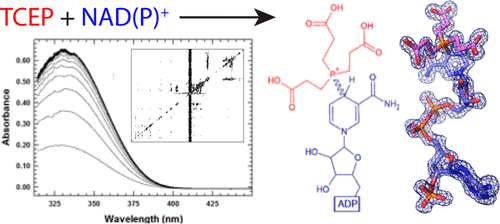当前位置:
X-MOL 学术
›
Biochemistry
›
论文详情
Our official English website, www.x-mol.net, welcomes your
feedback! (Note: you will need to create a separate account there.)
Cautionary Tale of Using Tris(alkyl)phosphine Reducing Agents with NAD+-Dependent Enzymes.
Biochemistry ( IF 2.9 ) Pub Date : 2020-08-25 , DOI: 10.1021/acs.biochem.0c00490 Sagar M Patel , Thomas G Smith , Martha Morton , Kyle M Stiers 1 , Javier Seravalli , Stephen J Mayclin 2 , Thomas E Edwards 2 , John J Tanner 1 , Donald F Becker
Biochemistry ( IF 2.9 ) Pub Date : 2020-08-25 , DOI: 10.1021/acs.biochem.0c00490 Sagar M Patel , Thomas G Smith , Martha Morton , Kyle M Stiers 1 , Javier Seravalli , Stephen J Mayclin 2 , Thomas E Edwards 2 , John J Tanner 1 , Donald F Becker
Affiliation

|
Protein biochemistry protocols typically include disulfide bond reducing agents to guard against unwanted thiol oxidation and protein aggregation. Commonly used disulfide bond reducing agents include dithiothreitol, β-mercaptoethanol, glutathione, and the tris(alkyl)phosphine compounds tris(2-carboxyethyl)phosphine (TCEP) and tris(3-hydroxypropyl)phosphine (THPP). While studying the catalytic activity of the NAD(P)H-dependent enzyme Δ1-pyrroline-5-carboxylate reductase, we unexpectedly observed a rapid non-enzymatic chemical reaction between NAD+ and the reducing agents TCEP and THPP. The product of the reaction exhibits a maximum ultraviolet absorbance peak at 334 nm and forms with an apparent association rate constant of 231–491 M–1 s–1. The reaction is reversible, and nuclear magnetic resonance characterization (1H, 13C, and 31P) of the product revealed a covalent adduct between the phosphorus of the tris(alkyl)phosphine reducing agent and the C4 atom of the nicotinamide ring of NAD+. We also report a 1.45 Å resolution crystal structure of short-chain dehydrogenase/reductase with the NADP+–TCEP reaction product bound in the cofactor binding site, which shows that the adduct can potentially inhibit enzymes. These findings serve to caution researchers when using TCEP or THPP in experimental protocols with NAD(P)+. Because NAD(P)+-dependent oxidoreductases are widespread in nature, our results may be broadly relevant.
中文翻译:

将三(烷基)膦还原剂与 NAD+ 依赖性酶结合使用的警示故事。
蛋白质生物化学方案通常包括二硫键还原剂,以防止不需要的硫醇氧化和蛋白质聚集。常用的二硫键还原剂包括二硫苏糖醇、β-巯基乙醇、谷胱甘肽以及三(烷基)膦化合物三(2-羧乙基)膦(TCEP)和三(3-羟丙基)膦(THPP)。在研究 NAD(P)H 依赖性酶 Δ 1 -pyrroline-5-carboxylate 还原酶的催化活性时,我们意外地观察到 NAD +与还原剂 TCEP 和 THPP之间的快速非酶化学反应。反应产物在 334 nm 处表现出最大紫外吸收峰,形成的表观缔合速率常数为 231–491 M –1 s –1. 该反应是可逆的,产物的核磁共振表征(1 H、13 C 和31 P)揭示了三(烷基)膦还原剂的磷与 NAD 烟酰胺环的 C4 原子之间的共价加合物+。我们还报告了 1.45 Å 分辨率的短链脱氢酶/还原酶晶体结构,NADP + –TCEP 反应产物结合在辅因子结合位点,这表明加合物可能会抑制酶。这些发现有助于在 NAD(P) +实验方案中使用 TCEP 或 THPP 时提醒研究人员。因为 NAD(P) +依赖的氧化还原酶在自然界中很普遍,我们的结果可能具有广泛的相关性。
更新日期:2020-09-15
中文翻译:

将三(烷基)膦还原剂与 NAD+ 依赖性酶结合使用的警示故事。
蛋白质生物化学方案通常包括二硫键还原剂,以防止不需要的硫醇氧化和蛋白质聚集。常用的二硫键还原剂包括二硫苏糖醇、β-巯基乙醇、谷胱甘肽以及三(烷基)膦化合物三(2-羧乙基)膦(TCEP)和三(3-羟丙基)膦(THPP)。在研究 NAD(P)H 依赖性酶 Δ 1 -pyrroline-5-carboxylate 还原酶的催化活性时,我们意外地观察到 NAD +与还原剂 TCEP 和 THPP之间的快速非酶化学反应。反应产物在 334 nm 处表现出最大紫外吸收峰,形成的表观缔合速率常数为 231–491 M –1 s –1. 该反应是可逆的,产物的核磁共振表征(1 H、13 C 和31 P)揭示了三(烷基)膦还原剂的磷与 NAD 烟酰胺环的 C4 原子之间的共价加合物+。我们还报告了 1.45 Å 分辨率的短链脱氢酶/还原酶晶体结构,NADP + –TCEP 反应产物结合在辅因子结合位点,这表明加合物可能会抑制酶。这些发现有助于在 NAD(P) +实验方案中使用 TCEP 或 THPP 时提醒研究人员。因为 NAD(P) +依赖的氧化还原酶在自然界中很普遍,我们的结果可能具有广泛的相关性。







































 京公网安备 11010802027423号
京公网安备 11010802027423号